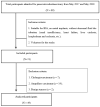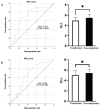The Relationship between Phase Angle, Nutrition Status, and Complications in Patients with Pancreatic Head Cancer
- PMID: 35682009
- PMCID: PMC9180801
- DOI: 10.3390/ijerph19116426
The Relationship between Phase Angle, Nutrition Status, and Complications in Patients with Pancreatic Head Cancer
Abstract
Phase angle (PhA), a bioimpedance parameter, is used to assess the nutrition status and body composition of patients. Patients with pancreatic head cancer often present with body composition changes that relate to adverse outcomes. PhA may be useful to evaluate prognosis in these patients, but data are deficient. We aim to explore the effects of PhA on nutrition evaluation and short-term outcome prediction in these patients. This prospective study included 49 participants with pancreatic head cancer who underwent pancreaticoduodenectomy (PD). All participants’ nutritional status and postoperative complications were assessed using nutrition assessment tools and the Clavien−Dindo classification method, respectively. Spearman correlation analyses were used to evaluate the association between PhA, nutrition status, and postoperative complications. ROC curves were generated to evaluate the ability of PhA to predict malnutrition and complications and to determine the cutoff value. The PhA values of the nutritional risk group and the malnourished group were significantly lower than those of the well-nourished group (p < 0.05). PhA positively correlated with patients’ nutrition status. Nineteen patients had postoperative complications, and the PhA value of the complication group was significantly lower than that of the non-complication group (4.94 vs. 5.47, p = 0.013). ROC curves showed that the cutoff point of PhA to predict malnutrition was 5.45 (AUC: 0.744), and the cutoff point of PhA to predict postoperative complications was 5.35 (AUC: 0.717). Our study indicates that PhA was associated with nutrition status and could be considered a nutrition assessment tool for pancreatic head cancer patients and predict the postoperative complications of these patients who have undergone PD.
Keywords: bioelectrical impedance analysis; complications; nutrition status; pancreatic head cancer; phase angle.
Conflict of interest statement
The authors declare that the research was conducted without any commercial or financial relationships that could be construed as a potential conflict of interest.
Figures




Similar articles
-
Impact of phase angle on postoperative prognosis in patients with gastrointestinal and hepatobiliary-pancreatic cancer.Nutrition. 2020 Nov-Dec;79-80:110891. doi: 10.1016/j.nut.2020.110891. Epub 2020 Jun 6. Nutrition. 2020. PMID: 32731162
-
Association Between Standardized Phase Angle, Nutrition Status, and Clinical Outcomes in Surgical Cancer Patients.Nutr Clin Pract. 2019 Jun;34(3):381-386. doi: 10.1002/ncp.10110. Epub 2018 Jun 5. Nutr Clin Pract. 2019. PMID: 29870080
-
Bioelectrical impedance phase angle and subjective global assessment in detecting malnutrition among newly diagnosed head and neck cancer patients.Eur Arch Otorhinolaryngol. 2016 May;273(5):1299-305. doi: 10.1007/s00405-015-3626-5. Epub 2015 Apr 10. Eur Arch Otorhinolaryngol. 2016. PMID: 25859939
-
Bioelectrical impedance analysis (BIA) phase angle in stroke patients: A systematic review.Clin Nutr. 2024 Dec;43(12):63-72. doi: 10.1016/j.clnu.2024.10.001. Epub 2024 Oct 11. Clin Nutr. 2024. PMID: 39426214
-
Association between phase angle and the nutritional status in pediatric populations: a systematic review.Front Nutr. 2023 Jun 21;10:1142545. doi: 10.3389/fnut.2023.1142545. eCollection 2023. Front Nutr. 2023. PMID: 37415913 Free PMC article.
Cited by
-
Phase Angle Predicts Malnutrition Risk and 6-month Mortality in Older Patients with Multimorbidity: A Retrospective Study.Clin Interv Aging. 2025 Jun 26;20:895-902. doi: 10.2147/CIA.S518795. eCollection 2025. Clin Interv Aging. 2025. PMID: 40599689 Free PMC article.
-
Phase angle at bioelectric impedance analysis is associated with detrimental sperm quality in idiopathic male infertility: a preliminary clinical study.Front Endocrinol (Lausanne). 2024 Apr 24;15:1354733. doi: 10.3389/fendo.2024.1354733. eCollection 2024. Front Endocrinol (Lausanne). 2024. PMID: 38721147 Free PMC article.
-
Association of bioelectrical impedance phase angle and nutritional status in patients undergoing pancreaticoduodenectomy.Front Nutr. 2025 Jul 16;12:1554535. doi: 10.3389/fnut.2025.1554535. eCollection 2025. Front Nutr. 2025. PMID: 40740641 Free PMC article.
-
Phase Angle and Postoperative Complications in a Model of Immunonutrition in Patients with Pancreatic Cancer.Nutrients. 2023 Oct 11;15(20):4328. doi: 10.3390/nu15204328. Nutrients. 2023. PMID: 37892404 Free PMC article.
-
Diagnostic and prognostic utility of phase angle in patients with cancer.Rev Endocr Metab Disord. 2023 Jun;24(3):479-489. doi: 10.1007/s11154-022-09776-z. Epub 2022 Dec 9. Rev Endocr Metab Disord. 2023. PMID: 36484944 Review.
References
-
- Gilliland T.M., Villafane-Ferriol N., Shah K.P., Shah R.M., Tran Cao H.S., Massarweh N.N., Silberfein E.J., Choi E.A., Hsu C., McElhany A.L., et al. Nutritional and Metabolic Derangements in Pancreatic Cancer and Pancreatic Resection. Nutrients. 2017;9:243. doi: 10.3390/nu9030243. - DOI - PMC - PubMed
Publication types
MeSH terms
LinkOut - more resources
Full Text Sources
Medical

